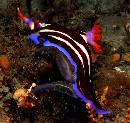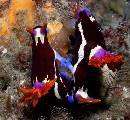 "The
Red-Gilled Nembrotha is a large brightly coloured seaslug and its vivid colours
and interesting charisma make it my favourite nudibranch species"
"The
Red-Gilled Nembrotha is a large brightly coloured seaslug and its vivid colours
and interesting charisma make it my favourite nudibranch species"Family: Polyceridae
 "The
Red-Gilled Nembrotha is a large brightly coloured seaslug and its vivid colours
and interesting charisma make it my favourite nudibranch species"
"The
Red-Gilled Nembrotha is a large brightly coloured seaslug and its vivid colours
and interesting charisma make it my favourite nudibranch species"
The Red-Gilled Nembrotha (Nembrotha rutilans) is one of the larger nudibranch species that belongs to the nudibranch family Polyceridae. It is considered to be a tropical nudibranch species as it prefers warmer tropical waters and has been recorded from locations such as Indonesia, Malaysia, Africa, the Great Barrier Reef, and along the NSW coast as far south as Sydney. This species is often confused with its close relative the Lined Nembrotha (Nembrotha lineolata).
 This
species is best recognised by its large red gills and bright red rhinophores
(nudibranch horns!). Its body colour is generally a deep purple/chocolate colour
with white patches along the side and a bright blue coloured under body. Most
species of nudibranchs are able to retract their gills into a pocket in their
body however the Red-Gilled Nembrotha is unable to retract its gills into the
mantle.
This
species is best recognised by its large red gills and bright red rhinophores
(nudibranch horns!). Its body colour is generally a deep purple/chocolate colour
with white patches along the side and a bright blue coloured under body. Most
species of nudibranchs are able to retract their gills into a pocket in their
body however the Red-Gilled Nembrotha is unable to retract its gills into the
mantle.
 Larvae
of the species occasionally drift down on the East Australian current into the
waters of New South Wales, and if conditions are right and an appropriate food
source is available this species may settle in an area and mature.
Larvae
of the species occasionally drift down on the East Australian current into the
waters of New South Wales, and if conditions are right and an appropriate food
source is available this species may settle in an area and mature.
 This
species can be found along the Australian coast feeding on the yellow-lined
ascidian Clavelina meridionalis which appears to be one of their favourite food
sources. The yellow lined ascidian is commonly found in sheltered bays that
have good current flow and the Red-Gilled Nembrotha is often found in close
proximity. This nudibranch uses it radula, a file like mouthpiece, to bite through
its soft tissued prey.
This
species can be found along the Australian coast feeding on the yellow-lined
ascidian Clavelina meridionalis which appears to be one of their favourite food
sources. The yellow lined ascidian is commonly found in sheltered bays that
have good current flow and the Red-Gilled Nembrotha is often found in close
proximity. This nudibranch uses it radula, a file like mouthpiece, to bite through
its soft tissued prey.

 This
nudibranch is a hermaphrodite meaning that both partners receive sperm from
the other during mating. In many nudibranchs the female opening (vagina) is
just an opening on the right side of the body, sometimes raised on a slight
swelling but often not. The Red-Gilled Nembrotha's vaginal opening and the penial
papilla are at the end of a long stalk, which is everted during mating (as indicated
in photo). The species may mate on multiple occasions in a short period of time
and has also been observed staying with the same partner for up to one month.
This
nudibranch is a hermaphrodite meaning that both partners receive sperm from
the other during mating. In many nudibranchs the female opening (vagina) is
just an opening on the right side of the body, sometimes raised on a slight
swelling but often not. The Red-Gilled Nembrotha's vaginal opening and the penial
papilla are at the end of a long stalk, which is everted during mating (as indicated
in photo). The species may mate on multiple occasions in a short period of time
and has also been observed staying with the same partner for up to one month.
This species can grow to a length of approximately 12 cms.